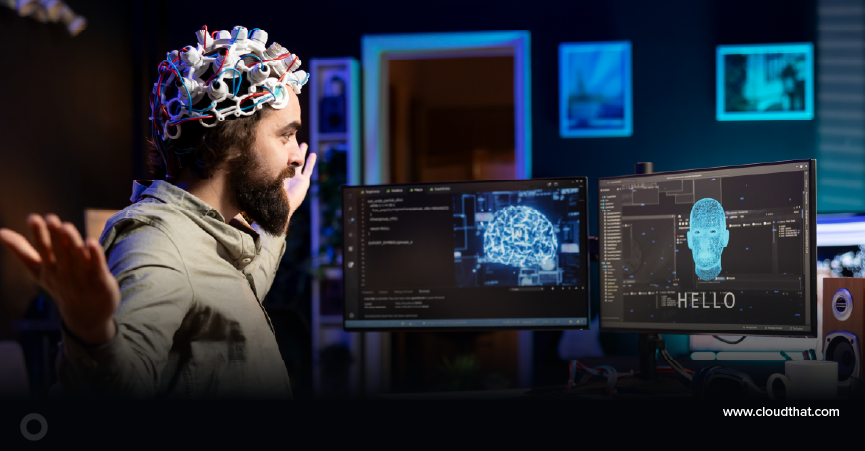|
Voiced by Amazon Polly |
Overview
In this detailed step-by-step guide, we embark on a journey into home automation by seamlessly integrating AWS IoT with the NodeMCU IoT device. The objective is to empower enthusiasts to create an intelligent and interconnected home environment, leveraging the Internet of Things (IoT) capabilities. Here, we are setting up AWS IoT to configure the NodeMCU connections.
Pioneers in Cloud Consulting & Migration Services
- Reduced infrastructural costs
- Accelerated application deployment
Introduction
Home automation has evolved, offering smarter and more connected living spaces. In this blog, we will delve into home automation using AWS IoT and NodeMCU. This step-by-step guide will empower you to harness the Internet of Things (IoT) capabilities for creating an intelligent and interconnected home environment.
Prerequisites
Before diving into the project, ensure you have the following prerequisites:
- An AWS account with access to AWS IoT services.
- NodeMCU development board and a basic understanding of how to program it.
- A Wi-Fi network for connecting NodeMCU to the internet.
- Basic familiarity with MQTT (Message Queuing Telemetry Transport) protocol.

Source: Google
Step-by-Step Guide
Step 1: Set Up AWS IoT
- Navigate to the AWS IoT Console and create a new Thing.
- Generate and download security certificates for secure communication.
- Create an IoT policy to define permissions for your Thing.
Step 2: Configure NodeMCU
- Install the necessary libraries for NodeMCU development using the Arduino IDE.
- Write a simple Arduino script to connect NodeMCU to your Wi-Fi network and AWS IoT.
- Copy code
|
1 2 3 4 5 6 7 8 9 10 11 12 13 14 15 16 17 18 19 20 21 22 23 24 25 26 27 28 29 30 31 32 33 34 35 36 37 38 39 40 |
// Include necessary libraries #include <ESP8266WiFi.h> #include <PubSubClient.h> // Replace with your Wi-Fi and AWS IoT credentials const char* ssid = "your-SSID"; const char* password = "your-PASSWORD"; const char* awsEndpoint = "your-iot-endpoint"; const char* clientId = "your-client-id"; const char* topic = "your-topic"; // Create a Wi-Fi client and an MQTT client WiFiClient espClient; PubSubClient client(espClient); void setup() { // Connect to Wi-Fi WiFi.begin(ssid, password); while (WiFi.status() != WL_CONNECTED) { delay(1000); Serial.println("Connecting to WiFi..."); } Serial.println("Connected to WiFi"); // Set up MQTT client client.setServer(awsEndpoint, 8883); } void loop() { // Connect to AWS IoT if (!client.connected()) { Serial.println("Connecting to AWS IoT..."); if (client.connect(clientId)) { Serial.println("Connected to AWS IoT"); client.subscribe(topic); } } // Your code here for home automation tasks } |
- Upload the script to NodeMCU
Step 3: Test the Setup
- Open the Serial Monitor in the Arduino IDE to monitor the connection status.
- Verify that NodeMCU successfully connects to both Wi-Fi and AWS IoT.
- Test the communication by publishing and subscribing to MQTT topics.
Step 4: Implement Home Automation Tasks
- Integrate sensors or actuators based on your home automation requirements.
- Modify the Arduino script to interact with these devices.
- Use AWS IoT Rules and AWS Lambda functions to process and analyze data.

Source: UBC
Conclusion
Experiment, customize, and enhance your setup to create a truly intelligent home.
Drop a query if you have any questions regarding AWS IoT or NodeMCU and we will get back to you quickly.
Making IT Networks Enterprise-ready – Cloud Management Services
- Accelerated cloud migration
- End-to-end view of the cloud environment
About CloudThat
CloudThat is an award-winning company and the first in India to offer cloud training and consulting services worldwide. As a Microsoft Solutions Partner, AWS Advanced Tier Training Partner, and Google Cloud Platform Partner, CloudThat has empowered over 850,000 professionals through 600+ cloud certifications winning global recognition for its training excellence including 20 MCT Trainers in Microsoft’s Global Top 100 and an impressive 12 awards in the last 8 years. CloudThat specializes in Cloud Migration, Data Platforms, DevOps, IoT, and cutting-edge technologies like Gen AI & AI/ML. It has delivered over 500 consulting projects for 250+ organizations in 30+ countries as it continues to empower professionals and enterprises to thrive in the digital-first world.
FAQs
1. What is AWS IoT, and why use it for home automation with NodeMCU?
ANS: – AWS IoT is a managed service that enables secure, scalable, and efficient communication between IoT devices and the cloud. Using it with NodeMCU ensures a reliable and scalable foundation for home automation.
2. Why choose NodeMCU for home automation projects?
ANS: – NodeMCU is a versatile and cost-effective IoT development board based on the ESP8266. It’s well-suited for home automation due to its Wi-Fi connectivity, ease of programming, and compatibility with popular IoT platforms like AWS.
3. What is MQTT, and why is it used in this context?
ANS: – MQTT (Message Queuing Telemetry Transport) is a lightweight and efficient messaging protocol designed for low-bandwidth, high-latency, or unreliable networks. It’s ideal for IoT applications, facilitating communication between NodeMCU and AWS IoT.

WRITTEN BY Karthik Kumar P V
Karthik Kumar Patro Voona is a Research Associate (Kubernetes) at CloudThat Technologies. He Holds Bachelor's degree in Information and Technology and has good programming knowledge of Python. He has experience in both AWS and Azure. He has a passion for Cloud-computing and DevOps. He has good working experience in Kubernetes and DevOps Tools like Terraform, Ansible, and Jenkins. He is a very good Team player, Adaptive and interested in exploring new technologies.


 Login
Login


 December 5, 2023
December 5, 2023 PREV
PREV










Comments